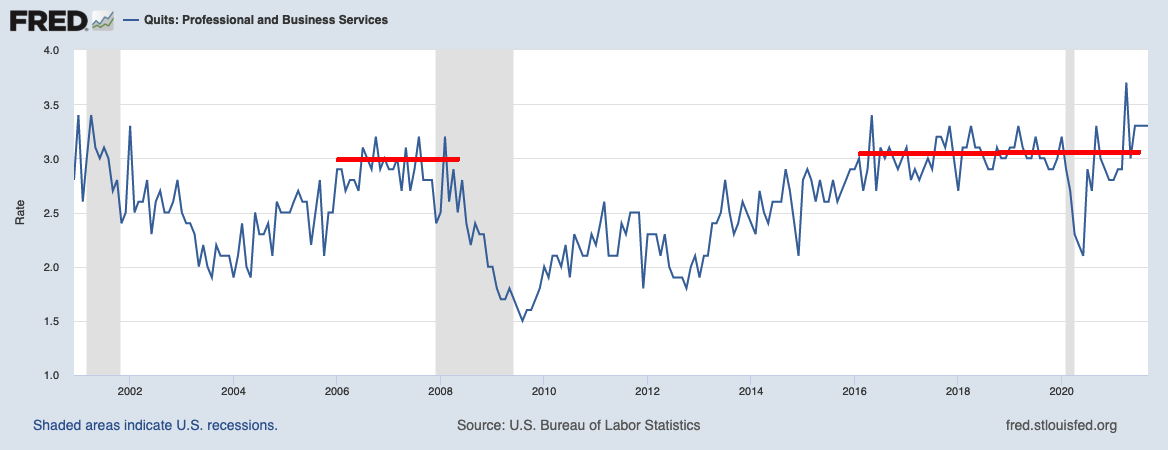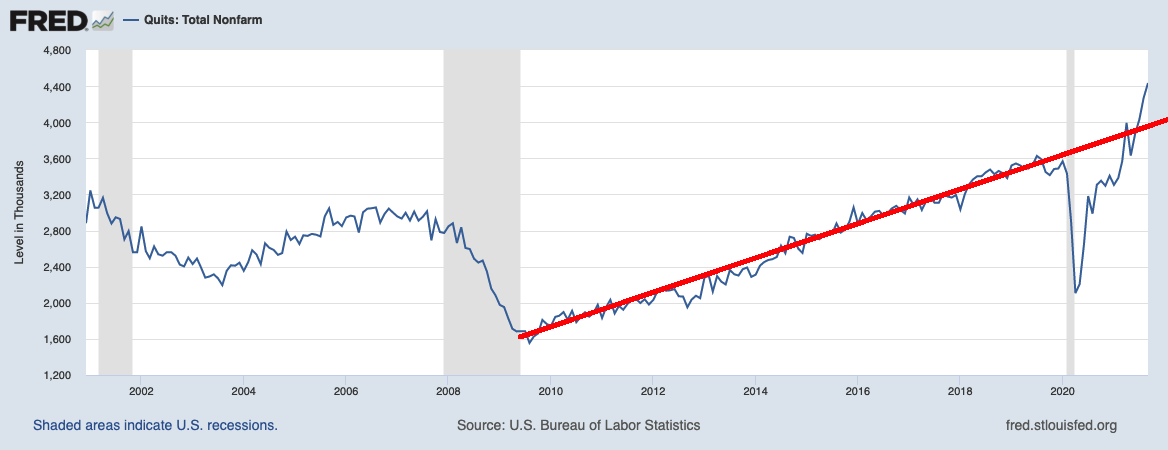Quits: Professional & Business Services

To hear an audio spoken word version of this post, click here.
“The number of U.S. workers quitting their jobs in September was the highest on record.” –New York Times
“The Great Resignation 2021: People quitting jobs in droves” –NPR
Catchy phrases in headlines make for great clickbait, but they are often lacking nuance or context. Case in point, “The Great Resignation.”
We have been discussing wages and employment forever around here. There is a massive transformation going on in the Labor markets, but it is easy to lose sight of what is occurring beneath the surface. Let’s see if we can clarify this.
Start with the two charts above: The first shows the total Quits Rate for all NonFarm payroll workers since the Great Financial Crisis (GFC) ended in 2009, the clear trend is a quits rate that has steadily marched higher for all workers and accelerated this year. I want to take this data apart a bit and analyze who is leaving their jobs and why.
Consider the second chart Quits: Professional & Business Services. These are various white-collar workers who managed to do pretty okay during the pandemic. While the overall trend has had an upward bias since the end of the GFC, for the professional class it’s been mostly sideways the past few years. That’s instructive because it’s telling us that the great resignation is primarily taking place at the lower half of the employment wage scale, entry-level jobs, or those tiers just above them.
We discussed their advantages recently in Embedded Technology:
“Circumstances allowed easy access to the full suite of work tools for professionals to easily work from home. This includes creatives, finance professionals, legal, accounting, media, etc. Those groups all have an enormous amount of flexibility to where and how they do their jobs.
Is it surprising that hospitality, food service, health care, retail workers are fleeing those fields to enter the white collar workforce? It’s more than just money: It represents autonomy and a measure of control to feel less like a serf and more like a self-determined professional.”
If this trend continues, it would be a significant break from the power dynamics of the 3 decades prior to the GFC. This has deep ramifications for the economy.
Companies whose business model is reliant on cheap labor are running into problems. If your company pays minimum wage or just over, expect to have a hard time finding workers. Even worse, if your employees are also on SNAP and/or Aid to Families with Dependent Children, then expect high turnover, low morale, and a decreasing pool of applicants to select from.
Part of the current problem traces its source back to the failure of the Federal Government to raise the minimum wage appreciably. The minimum wage has not kept up with inflation or productivity or corporate profits for decades; aggressive lobbying by minimum wage companies is why. Hence, these same firms now find themselves short-staffed, chasing the wealthy better-run companies like Amazon, BJ’s, and Starbucks for workers.
Instead of gradually raising the minimum wage over time nationally, first to $10, then $12, and putting it on a path towards $15, we have seen the pressure build for years . . . then during the pandemic lockdown, we experienced an 18 month period when low-wage workers reconsidered their careers. The dam broke, the results being both a sudden spike in wages and a shortage of workers.
In other words, you can blame the current labor mess in part on the firms that are suffering the most — they contributed to these circumstances. I expect a reckoning among many less efficient, poorly managed companies, those with bad business models, overly reliant on cheap labor. These businesses will disappear, and some will blame the pandemic or mask mandates or “wokeness” or some other excuse, but the simple facts are these were not robust or profitable firms. The survivors, on the other hand, have to be.
The “Great Resignation” is a backward-looking phrase. Lower paid labor has upskilled, gotten certified, degreed, leveled up, found new fields to work in, launched new apps. What we have instead are millions of people launching small businesses, striving for the middle class, entrepreneurship, and self-determination. I wrote some time ago that the future of new business is disrupting old business; that is a better descriptor of what is going on now: The Great Disruption.
Previously:
Shifting Balance of Power? (April 16, 2021)
Elvis (Your Waiter) Has Left the Building (July 9, 2021)
Finding it Hard to Hire? Try Raising Your Wages (May 6, 2021)
The Future of New Business is Disrupting Old Business (February 7, 2015)
How McDonald’s and Wal-Mart Became Welfare Queens (Nov 13, 2013)
click for audio


